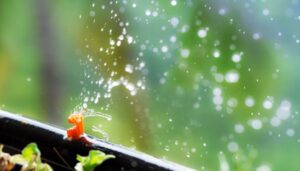The productive potential of an orchard is directly related to the cultural management that ensures the integrity of the plant in the extensive post-harvest period, which also coincides with the period of floral differentiation and with a very important moment, which is the accumulation of carbon reserves and nitrogenous.
The postharvest period begins about 90-120 days after full flower (DDPF) and is recognized as the root recovery period of orchards in most rootstocks. This root recovery is associated with two very important processes, such as nutrition management and irrigation programming.
In general, much of the nutrition in cherry trees is focused on postharvest. In vigorous or medium vigor rootstocks, postharvest nitrogen fertilization should be incorporated around 70 to 80% of the annual amount, as well as with respect to potassium and finish completing the demand for other nutrients such as magnesium, often calcium and phosphorus. In this sense, cherry postharvest, in nutritional terms, should not be neglected.
“If we look at the action of the root system in full development, it is adapted and practically coordinated and programmed to grow, absorb and take advantage of all that is the nutritional component in terms of recovery”commented Carlos Tapia, Avium Director.
In terms of irrigation, if the plant is developing its root system, it is directly related to improving, maintaining or perfecting the entire postharvest irrigation schedule. It is super important to face irrigation at this time, from the point of view of the distribution of soil water, not necessarily the amount of water that is being placed is sufficient, but that amount has to be somehow related to the efficient distribution of water on the ground.
“The literature speaks of the decrease in postharvest crop coefficients, but it has been recognized in Chile that postharvest crop coefficients can often be high, even reaching close to 1.4, considering the efficiency of the different irrigation systems, the capacity of the plant to take this water from the soil, the climatic conditions, the development, the vigor condition of the trees among others, therefore one should not only talk about the importance of the postharvest in terms of preventing stress with the use of some agents, such as sunscreens, but also as the best way to present soil nutrition, associated with optimal and timely management in this periodTapia added.
For its part, any anomaly from the point of view of stress in this period is directly detrimental to the accumulation of reserves and in parallel to the formation and development of floral primordia in the fruit centers that will participate in the production of the next season. Therefore, it is imponderable to avoid it so as not to interrupt these fundamental processes in production.Postharvest stress can occur, among other factors, due to an abiotic effect, mainly due to water deficit and/or excess temperature, and a biotic one caused by a pest or disease. Abiotic stress occurs mainly because plants, generally with less vegetative development and/or with deficit irrigation, do not have the capacity for continuous gas exchange with the atmosphere, producing stomatal closure, not capturing CO2 for the generation of sugars and a bad formation of flower primordia in the fruit centers, generating loss of fertility and malformations in fruits. It is necessary to consider that the floral induction period (IF) begins approximately 70 days after full flower (DDPF) and the floral differentiation period (DF) begins approximately 100 DDPF, both processes being highly dependent on water and thermal stability in the plant in those moments of greatest atmospheric demand.











